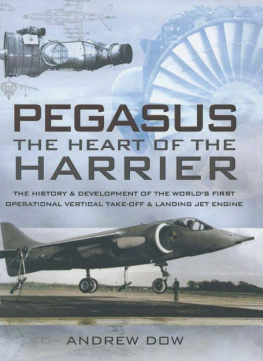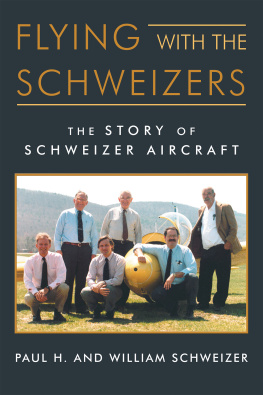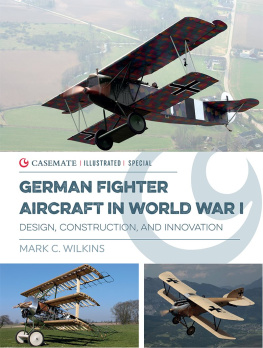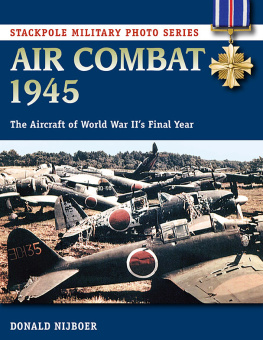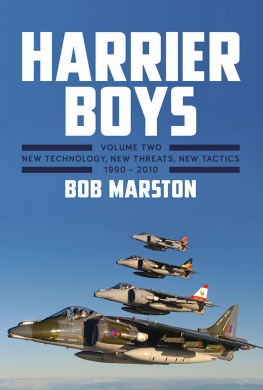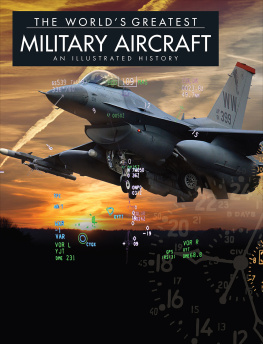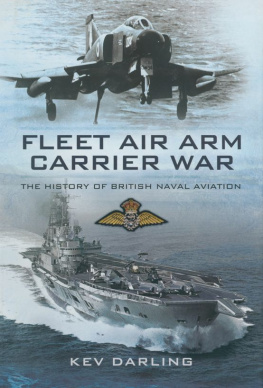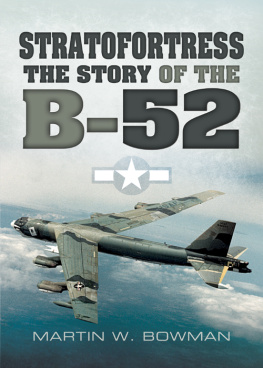PEGASUS
The Heart of the Harrier
Andrew Dow, who was known as George to his colleagues in the aviation industry, joined Bristol Siddeley as a commercial apprentice in 1962. In 1975 he was appointed as commercial manager, Pegasus, and remained responsible for the engines commercial fortunes for sixteen years. This is his fourth book.
By the same author
Norfolk & Western Coal Cars
Telling the Passenger Where to Get Off
Dows Dictionary of Railway Quotations
PEGASUS
The Heart of the Harrier
The History and Development
of the Worlds First Operational
Vertical Take-off and Landing
Jet Engine
Andrew Dow

Pen & Sword
AVIATION
First published in Great Britain in 2009 by
Pen & Sword Aviation
an imprint of
Pen & Sword Books Ltd
47 Church Street
Barnsley
South Yorkshire
S70 2AS
Copyright Andrew Dow, 2009
ISBN: 978 1 84884 042 3
The right of Andrew Dow to be identified as author of the work
has been asserted by him in accordance with the
Copyright, Designs and Patents Act 1988.
A CIP catalogue record for this book is available from
the British Library
All rights reserved. No part of this book may be reproduced or transmitted in any
form or by any means, electronic or mechanical including photocopying, recording or
by any information storage and retrieval system, without permission from the
Publisher in writing.
Typeset in Sabon by S L Menzies-Earl
Printed in the UK by CPI
Pen & Sword Books Ltd incorporates the imprints of:
Pen & Sword Aviation, Pen & Sword Maritime, Pen & Sword Military,
Wharncliffe Local History, Pen & Sword Select, Pen & Sword Military
Classics, Leo Cooper, Remember When, Seaforth Publishing and
Frontline Publishing.
For a complete list of Pen & Sword titles please contact:
Pen & Sword Books Limited
47 Church Street, Barnsley, South Yorkshire, S70 2AS, England
E-mail: enquiries@pen-and-sword.co.uk
Website: www.pen-and-sword.co.uk
Dedication
To Gordon Lewis
and
all members of the Pegasus team
past, present and future
Contents
T his book describes in great detail how the Pegasus engine of the Harrier came into being, and was developed to its full potential. As such it is an authoritative and valuable addition to the library of serious historical records of mans conquest of the air.
However, the book is so much more than that. Unlike many technical stories it has a genuine beginning, middle and end. In many places it is also a real page turner, thanks to the depth of the research that the author has undertaken. It is a truly fascinating description of a story that goes way beyond the Pegasus itself, and has to do with a major part of military aviation thinking in the second half of the twentieth century.
It also provides food for thought about why there are so many books about particular aircraft but so few about the engines that power them. While the books mention the engines, this is often almost in passing. There are many possible reasons for this, not least of which is that there were frequently several engines that could have been fitted to any particular aircraft. It may be difficult to imagine a Spitfire or Hurricane without the Merlin engine, but there were other engines available.
However, in the case of the Pegasus and the Harrier their relationship was unique. They turned out to be totally dependent on each other. While the two engine and airframe design teams may not have been married in a church, they certainly lived together all the time, and without any counter-productive external affairs. As with the best relationships, the teams had the greatest respect for each other, and each was led at different stages by outstanding individuals. With such an ideal set-up, perhaps it is not surprising that if the job was just possible it was going to be done.
I can say all this because I was fortunate to be an insider on the programme from 1964 to 1983. What a privilege that was, and what a tremendous satisfaction it is to me that Andrew Dow has done his job to the highest standards of the Pegasus programme.
John Farley
Former Harrier chief test pilot
I n September 2005, Rolls-Royce organised an event to mark the end of Pegasus engine production. I had managed to obtain an invitation, and although I had left the company fourteen years earlier, I slipped easily into conversation with former colleagues such as John Bryant, Mike Gladwin and Gordon Lewis. I found that, to paraphrase on old American saying, while you could take the boy out of the Pegasus, you could not take the Pegasus out of the boy. After much thought about the work involved, I admitted to myself that I would have to write the history of the engine.
The resulting book, like its subject, is very much the product of a team. Indeed, it comes essentially from many of the same team who conceived, designed, built, tested, manufactured, sold, flew and supported a remarkable turbofan engine. All of us, each in our own way, have been extraordinarily proud to have been associated with the Pegasus engine, sensing all the time that, no matter how humble or mundane our contribution, we were all part of creating and maintaining a truly remarkable engine and airframe combination. That sense of history and pride survives to this day within the current Pegasus team.
Whether we made our efforts under the banner of Bristol Aero Engines, Bristol Siddeley or Rolls-Royce, we were part of a unique piece of engineering and a unique piece of aviation. Very many former colleagues and members of that team have been of material assistance to me in drawing together the facts, and in dispelling the myths, that are all part of the Pegasus story. My part, my privilege, has been merely to draw those facts together and present them, I hope, in an informative and interesting manner. I have tried to avoid obscure engineering language and terminology, as well as the temptation to show power curves, performance graphs and discussions upon pressure ratios. However, the use of some engineering terminology and explanation was unavoidable, and I urge those readers who, like me, do not possess qualifications in aerodynamics, mechanical engineering or combustion technology to bear with me and allow me to lead you through the fascinating world of vectored thrust, elephants trousers, four-poster technology, wiggle strips, short lift wet, hot re-slams and Blot Flops.
It was my great good fortune, in late 1975, to join the Pegasus team as the first commercial manager for the engine, and I remained responsible for its commercial fortunes for sixteen years. Throughout that time I was strongly aware that the engine had been brought to life as a private venture by Bristol, and that it was the last Bristol product to bear a name in the Bristol tradition of the classics, rather than a mere type number. Other than a potential but unconsummated partnership with Pratt & Whitney in the 1970s, it was our sole effort, and not a collaborative engine project. Instead of having working-groups, committees, joint boards and all the complexities, delays and costs of international collaboration, we on the Pegasus team could make our decisions and get on with it. By the same process we knew that we stood or fell on what we did.
It was a remarkable turn of events that although the engine was supported by Ministry of Defence development contracts in its middle years, its final apotheosis was privately funded. It had to be that way, so that the strictures and complexities of US government
funding and politics would not stand in the way of necessary thrust and life enhancements for the US Marine Corps and, eventually, the Royal Air Force.
Next page
